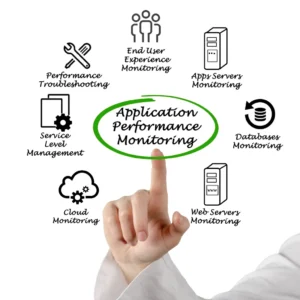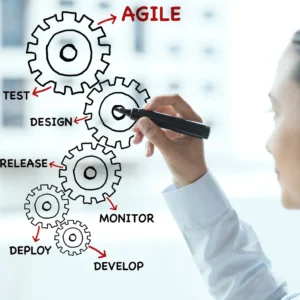
Harmonizing Horizons
Navigating Scalability and Integration in the Intelligent Process Automation (IPA) Landscape for Future-Ready Efficiency
Welcome to exploring the dynamic landscape of “Scalability and Integration in Intelligent Process Automation (IPA).” In today’s digital era, businesses and technical solution providers seek comprehensive insights into optimizing automation workflows.
This series delves into crucial subtopics, shedding light on innovative strategies and protocols that propel Intelligent Process Automation to new heights.
This article emphasizes the significance of implementing security measures in integration processes. As businesses increasingly embrace automation, safeguarding data exchange and ensuring compliance with ethical standards become central to success.
We will navigate through strategic implementations, innovative approaches, and adaptive protocols, emphasizing the pivotal role of security in establishing a robust foundation for scalable and seamlessly integrated Intelligent Process Automation workflows.
Join us on this journey as we unravel the intricacies of fortifying integration for the future of automation.
Scalability Strategies for Automation Workloads
Achieving Seamless Growth: Strategic Scalability in Intelligent Process Automation (IPA)
The need for scalable solutions is paramount in the realm of Intelligent Process Automation (IPA). As businesses witness fluctuations in workloads, deploying scalable automation strategies becomes pivotal for sustained efficiency and performance.
Implementing scalability strategies requires a thoughtful and strategic approach. Effective workload management requires dynamic resource allocation for optimal distribution of resources. This adaptive approach facilitates the efficient management of automation processes.
Horizontal and vertical scaling, innovative approaches in IPA, offer flexibility in accommodating diverse business scenarios. Striking a delicate balance between efficiency and performance is crucial for scalable automation workload management. Proactive planning is essential to guarantee continuity in high-volume automation processes.
Ethical and transparent scalability practices are vital, governed by frameworks prioritizing compliance with standards and best practices. User-centric design principles are pivotal in optimizing the user experience within scalable automation environments, ensuring smooth transitions amid varying operational scenarios.
Dynamic scalability measures are indispensable to adapt to fluctuating workload demands. These measures enable automation processes to adjust seamlessly to changing business and operational landscapes. In essence, scalability in IPA is not just a technical necessity but a strategic imperative.
In conclusion, the strategic implementation of scalability strategies, complemented by proactive planning and ethical governance, forms the bedrock of a robust IPA framework. Adapting to varied business scenarios, optimizing user experience, and ensuring compliance are the cornerstones of successful scalability in Intelligent Process Automation.
Integration with Enterprise Systems
Seamless Integration: Elevating Intelligent Process Automation (IPA) in Enterprise Systems
Integrating seamlessly with enterprise systems is imperative in the realm of Intelligent Process Automation (IPA). Strategic protocols ensure smooth integration, fostering compatibility and fluid data flow between IPA and core business systems.
Balancing automation with human oversight is vital, achieved through effective integration with enterprise solutions. Dynamic data exchange strategies streamline communication, enhancing synergy between IPA and enterprise systems. Governance frameworks uphold ethical and transparent integration practices, fostering collaboration across business platforms.
Proactive planning is essential for secure and efficient data transfer, adapting to both on-premises and cloud environments. Adaptive integration protocols accommodate varied enterprise system architectures and technologies, ensuring flexibility in implementation.
User-centric design principles optimize the user experience within integrated business environments, promoting a harmonious interaction between users and automated processes. Compliance with integration standards and regulations is prioritized, establishing a foundation for trustworthy business process automation.
Collaborative platforms and tools are pivotal in implementing and managing effective enterprise system integration in IPA. In essence, seamless integration is not just a technical necessity but a strategic imperative for unlocking the full potential of Intelligent Process Automation in enterprise settings.
Cloud Integration and Scalability
Cloud Integration and Scalability in Intelligent Process Automation (IPA)
In the realm of Intelligent Process Automation (IPA), leveraging cloud infrastructure is a game-changer for scalability. Strategic protocols ensure seamless integration, allowing efficient data transfer between on-premises and cloud environments.
Balancing automation with human oversight is achieved through efficient cloud integration strategies. Dynamic resource allocation in cloud environments facilitates scalable automation workloads, adapting to varying business demands. Governance frameworks uphold ethical and transparent data transfer practices between on-premises and the cloud.
Proactive measures are paramount for secure and efficient data exchange in cloud-based automation processes. Adaptive cloud integration protocols accommodate diverse automation scenarios and business environments, ensuring flexibility and resilience.
User-centric design principles optimize the user experience within cloud-integrated automation, fostering a harmonious interaction between users and scalable processes. Compliance with cloud security standards and regulations is prioritized, establishing a secure foundation for Intelligent Process Automation.
Collaborative platforms and tools are pivotal in implementing and managing effective cloud integration and scalability in IPA. In essence, cloud integration is not just a technical enhancement but a strategic imperative for unlocking the full potential of Intelligent Process Automation in dynamic business landscapes.
Microservices Architecture in IPA
Embracing Scalability: The Power of Microservices Architecture in Intelligent Process Automation (IPA)
In the evolution of Intelligent Process Automation (IPA), microservices architecture emerges as a strategic asset. Protocols guide the implementation of this architecture, fostering modular and scalable automation.
Innovative approaches drive the design of microservices-based workflows, enhancing the adaptability of automation processes. The achievement of a delicate balance between automation and human oversight is made possible through scalable and interoperable microservices.
Dynamic resource allocation and communication protocols within a microservices framework ensure efficiency and cohesion. Governance frameworks uphold ethical and transparent implementation practices, establishing trust in microservices for IPA.
Proactive planning is essential for scalable and efficient automation processes, emphasizing the importance of microservices. Adaptive protocols cater to diverse business processes and automation scenarios, ensuring flexibility and resilience.
User-centric design principles optimize the user experience in microservices-based automation, enhancing usability and accessibility. Compliance with microservices standards and regulations is a priority, ensuring a secure foundation for IPA implementations.
Collaborative platforms and tools are pivotal in implementing and managing microservices architecture in Intelligent Process Automation. In essence, the strategic adoption of microservices amplifies IPA’s scalability and integration capabilities in the modern business landscape.
API Connectivity and Management
Navigating Connectivity: The Essence of API Management in Intelligent Process Automation (IPA)
Strategic protocols guide effective API connectivity in Intelligent Process Automation workflows, enhancing seamless integration. Innovative approaches ensure the harmonious inclusion of APIs in automation processes.
Balancing automation and human oversight relies on robust API management strategies. Dynamic data exchange protocols streamline communication across API-connected systems, promoting efficiency and cohesion.
Governance frameworks uphold ethical and transparent API integration practices in IPA, fostering trust in data exchange. Proactive measures secure efficient data transfer through API connections, ensuring data integrity and privacy.
Adaptive API management protocols cater to diverse automation scenarios and business environments, offering flexibility and resilience. User-centric design principles optimize the user experience in API-connected automation, prioritizing accessibility and usability.
Ensuring compliance with API security standards is paramount, establishing a secure foundation for Intelligent Process Automation. Collaborative platforms and tools are pivotal in implementing and managing effective API connectivity and management in IPA.
In essence, the strategic adoption of API connectivity and management is crucial for amplifying the scalability and integration capabilities of Intelligent Process Automation in contemporary business landscapes.
Data Integration Strategies
Crafting Harmony: Data Integration Strategies in Intelligent Process Automation (IPA)
Strategic protocols drive comprehensive data integration in Intelligent Process Automation workflows, fostering innovation. Innovative approaches seamlessly integrate data from diverse sources, enhancing the adaptability of IPA processes.
Balancing automation with human oversight relies on efficient and cohesive data integration. Dynamic data exchange strategies ensure seamless communication across systems, promoting synergy in automation workflows.
Governance frameworks uphold ethical and transparent data integration practices in IPA, establishing trust in the integration process. Proactive measures handle structured and unstructured data, ensuring the integrity of automation workflows.
Adaptive data integration protocols cater to business processes and automation scenarios, offering flexibility and resilience. User-centric design principles optimize the user experience in data-integrated automation, prioritizing accessibility and usability.
Ensuring compliance with data integration standards is paramount, providing a secure foundation for IPA implementation. Collaborative platforms and tools are crucial in implementing and managing effective data integration strategies in Intelligent Process Automation.
In essence, the strategic adoption of data integration strategies is pivotal for amplifying the scalability and integration capabilities of Intelligent Process Automation in the evolving landscape of business processes.
Legacy System Migration and Integration
Bridging Eras: Legacy System Migration and Integration in Intelligent Process Automation (IPA)
Strategic protocols guide seamless legacy system migration in Intelligent Process Automation, ensuring a smooth transition. Innovative approaches integrate automation processes with legacy systems, fostering adaptability.
Balancing automation and human oversight is achieved through secure and efficient legacy system integration. Dynamic strategies address updating and securing outdated technologies, promoting longevity in legacy systems.
Governance frameworks uphold ethical and transparent implementation practices in legacy system migration, building trust. Proactive measures identify and mitigate security risks in legacy system integration, ensuring a secure transition.
Adaptive integration protocols cater to varied legacy system architectures and technologies, providing flexibility. User-centric design principles optimize the user experience in legacy system compatibility, prioritizing accessibility and usability.
Establishing a secure foundation in legacy system integration is essential for ensuring compliance with security regulations and standards.
Collaborative platforms and tools are pivotal in implementing and managing effective legacy system migration and integration in IPA.
In essence, the strategic adoption of legacy system migration and integration is paramount for amplifying the scalability and integration capabilities of Intelligent Process Automation in the complex landscape of evolving technologies.
Cross-Platform Integration
Harmonizing Horizons: Cross-Platform Integration in Intelligent Process Automation (IPA)
Strategic protocols ensure seamless cross-platform integration in Intelligent Process Automation, fostering compatibility and synergy. Innovative approaches create unified strategies for balanced automation and human oversight.
Dynamic communication protocols facilitate smooth data exchange across diverse technologies. Governance frameworks uphold ethical and transparent cross-platform integration practices, building trust in IPA processes.
Proactive measures handle varied technologies and environments in integration workflows, promoting adaptability. Adaptive integration protocols cater to diverse business processes and platform automation scenarios, offering flexibility.
User-centric design principles optimize the user experience in cross-platform integrated automation, prioritizing accessibility. Ensuring compliance with cross-platform integration standards is essential for a secure foundation in IPA implementation.
Collaborative platforms and tools are pivotal in implementing and managing effective cross-platform integration strategies in Intelligent Process Automation. In essence, the strategic adoption of cross-platform integration enhances IPA’s scalability and integration capabilities in a diverse technological landscape.
Human and Bot Collaboration Integration
Orchestrating Harmony: Human and Bot Collaboration Integration in Intelligent Process Automation (IPA)
Strategic protocols integrate human and bot collaboration seamlessly in Intelligent Process Automation, fostering effective interaction. Innovative approaches cultivate cohesive integration strategies, balancing automation and human oversight.
Dynamic communication protocols facilitate smooth interaction between human and bot workflows, promoting synergy. Governance frameworks uphold ethical and transparent collaboration practices in IPA, establishing trust.
Proactive measures optimize workflows through effective human and bot interaction, enhancing productivity. Adaptive integration protocols cater to business processes and automation scenarios involving humans and bots, ensuring flexibility.
User-centric design principles elevate the user experience in human-bot collaborative environments, prioritizing engagement. Ensuring compliance with ethical and regulatory standards is vital for a secure foundation for human and bot interaction.
Collaborative platforms and tools play a pivotal role in implementing and managing effective human and bot collaboration integration in Intelligent Process Automation. Ultimately, strategic adoption enhances IPA’s scalability and integration capabilities in collaborative workflows.
Security Measures in Integration
Fortifying Integration: Security Measures in Intelligent Process Automation (IPA)
Implementing security measures in integration workflows safeguards Intelligent Process Automation, ensuring innovation. Innovative approaches secure data exchange across integrated systems, fostering reliability.
Balancing automation and human oversight relies on robust security protocols in integration processes, promoting trust. Dynamic security measures proactively identify and mitigate risks, ensuring a resilient integration landscape.
Governance frameworks uphold ethical and transparent security practices in integrated automation, building a foundation of integrity. Proactive measures safeguard sensitive information, prioritizing data security during integration processes.
Adaptive security protocols cater to varied integration scenarios and business environments, ensuring flexibility. User-centric design principles optimize the user experience in securely integrated systems, emphasizing usability and accessibility.
Ensuring compliance with security regulations and establishing a secure foundation for integration workflows is paramount. Collaborative platforms and tools are pivotal in implementing and managing effective security measures in IPA integration processes.
Conclusion
In conclusion, our exploration of “Scalability and Integration in Intelligent Process Automation (IPA)” underscores the critical significance of security measures within integration processes. As businesses march forward in their automation endeavours, the nexus of data exchange and ethical compliance emerges as the linchpin for sustained success.
The strategic implementation of security measures, innovative data exchange approaches, and dynamic risk mitigation protocols collectively fortify the foundation of Intelligent Process Automation. Businesses cultivate trust and reliability in their integrated systems by balancing automation with human oversight through robust security.
Governance frameworks play a pivotal role in instilling ethical and transparent security practices. Proactive measures for safeguarding sensitive information resonate as a proactive stance against evolving cyber threats. The adaptability of security protocols to varied scenarios showcases the resilience required in today’s diverse business environments.
As we advocate for user-centric design principles and collaborative platforms, the emphasis is not merely on securing data but optimizing the overall user experience. Ensuring compliance with security regulations solidifies the commitment to responsible automation practices.
In essence, this exploration underscores that security is not a peripheral consideration but an integral force shaping the future of automation. It acts as a catalyst for innovation, resilience, and trust, setting the stage for a harmonious integration of technology and business processes in the era of Intelligent Process Automation.
Related Articles
- Choosing the Right Automation Tool in 7 Steps
- A 9-Step Guide to IPA Implementation: Energise Your Operations
- Navigating the Roadblocks of IPA – The Top 9 Challenges
- AI in Intelligent Process Automation – Unleash the Power of AI
- 9 IPA Examples in Small-Scale Industries
- Power of Intelligent Business Process Automation – Efficiency
- AI Business Process Management: Unleashing the Power
- Business Process Management with AI Integration
- AI for Reengineering Business Processes
- Hyperautomation: Redefining BPM with AI
- The Role of AI in Business Process Modelling
- AI-driven Customer Onboarding – Unleash the Power of AI
- Effective Process mapping in Intelligent Process Automation
- Intelligent Process Automation Adoption – The Best Strategy Guide
- TechInfra in IPA: A Comprehensive Guide
- Elevating Intelligent Automation with Continuous Improvement
- Comprehensive Approach to Cost-Benefit Analysis in IPA
- Vendor Selection in IPA – Comprehensive Guide
- Implementing Agile in Intelligent Process Automation (IPA)
- Scalability and Integration in Intelligent Process Automation
- Cognitive Automation in IPA: Innovating Ethical Efficiency
- Mastering Symphony: Bot Development in IPA Unveiled
- UI/UX Mastery in IPA: Elevating Automation Experiences
- Compliance and Security in IPA – A Guide Ensuring Trust
- Impact of Performance Monitoring and Analytics in IPA
- Driving Success: Data Management in IPA
- Crucial Role: Documentation in IPA Triumph
- Optimizing IPA – Continuous Improvement Strategies

































